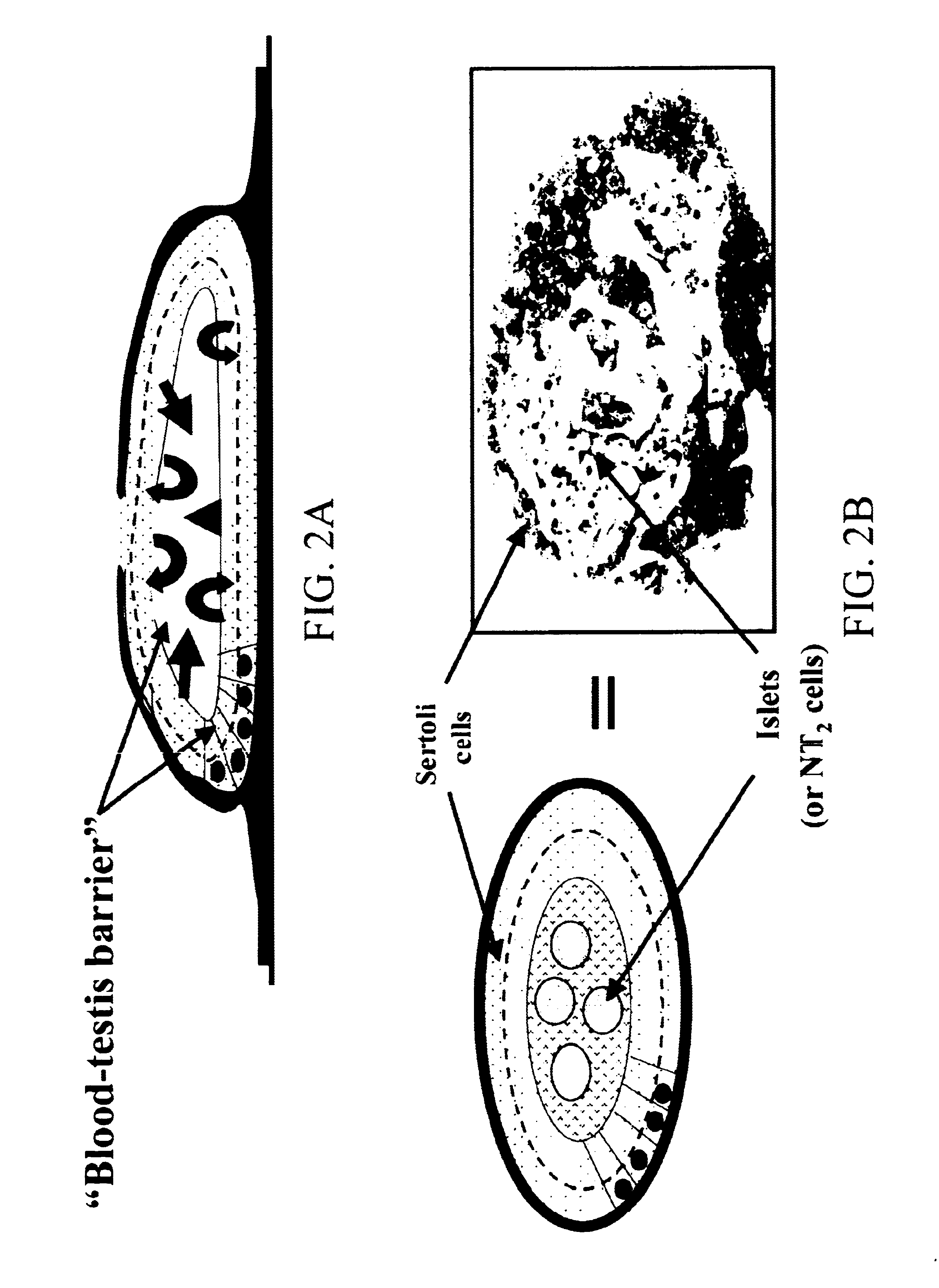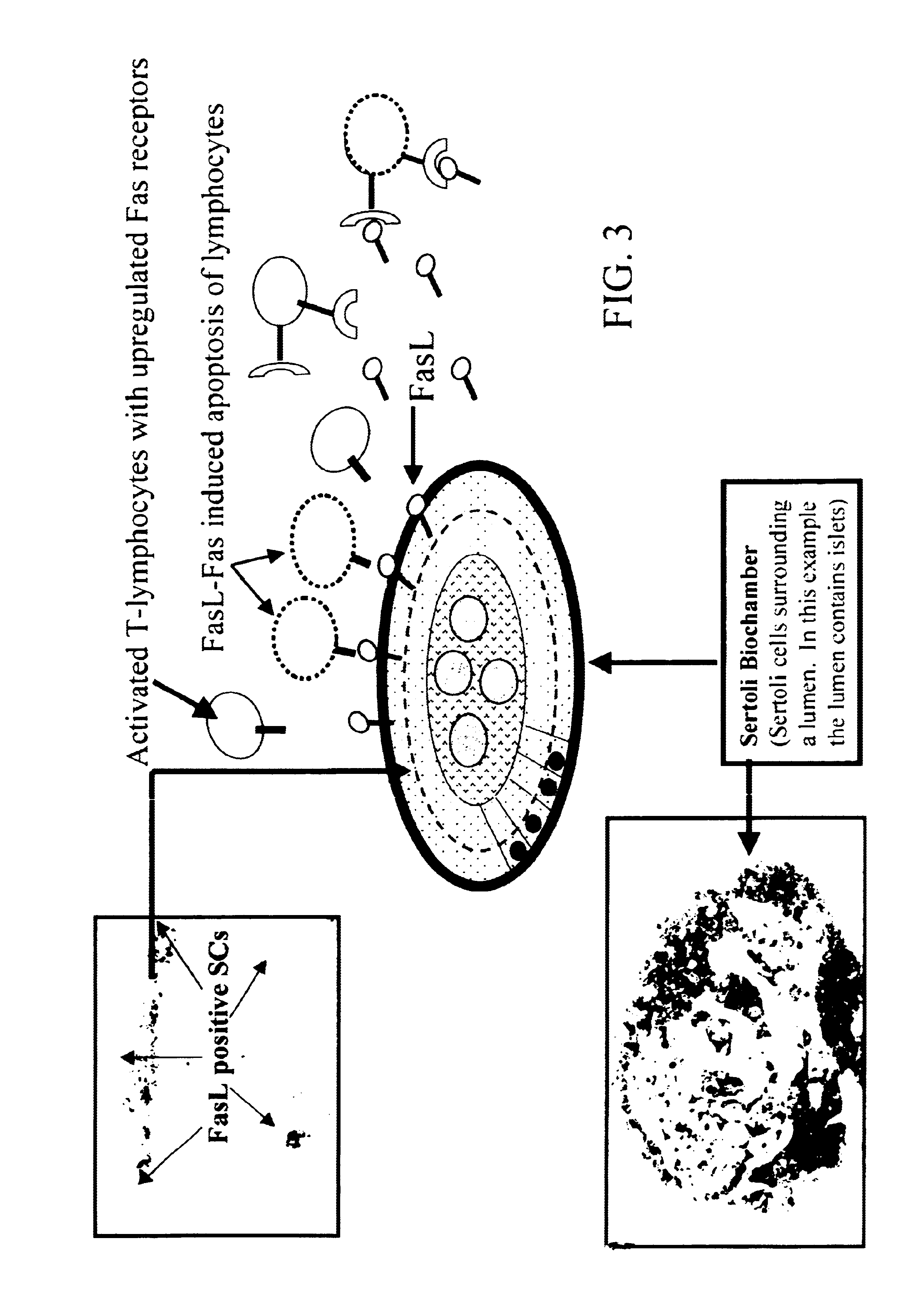Sertoli cells as biochambers
a technology of sertoli cells and biochambers, applied in the field of transplantation methods, can solve the problems of neuropathological damage and the consequent behavioral deficits not being reversed, graft rejection phenomenon remains problematic, and major health problems
- Summary
- Abstract
- Description
- Claims
- Application Information
AI Technical Summary
Problems solved by technology
Method used
Image
Examples
example 1
Recently, Sertoli cells have been utilized to facilitate islet transplantation on the basis that the testis-derived cells provide localized immunoprotection at the graft site and stimulate islet viability. The relationship between Sertoli cells and .beta.-cells is not yet well defined in vivo nor in vitro. To further evaluated this relationship and to promote Sertoli / islet cell 3-dimensional aggregation (SICA) in vitro, Sertoli cells and islets were co-cultured in simulated microgravity using the NASA high aspect rotation velocity (HARV) bioreactor.
Sertoli cells, harvested from mammals by methods as known by those of skill in the art, and islets, obtained by methods known to those of skill in the art as in Korbutt et al, were isolated from neonatal pigs by routine enzymatic digestion. Sertoli cells were. placed immediately into HARVs at the time of isolation. Isolated islets were pre-cultured in flasks for 14 days (to expedite the removal of exocrine tissue) prior to incubation in H...
example 2
Formation of Sertoli-neuron Aggregated Cells(SNACs) by Simulated Microgravity Coculture of Sertoli Cells and Imortalized NT2 Cells
Sertoli cells also have been utilized to facilitate the transplantation of dopaminergic cells into the brain as a treatment protocol for Parkinson's since Sertoli cells appear to provide localized immunoprotection at the graft site and to stimulate nerve cell viability: (Sanberg, P. R., C. V. Borlongan, A. I. Othberg, S. Saporta, T. B. Freeman and D. F. Cameron. Testis-derived Sertoli cells have a trophic effect on dopamine neurons and alleviate hemiparkinsonism in rats. Mature medicine, 3(10):1129-1132.). To enhance this transplantation treatment protocol, as was utilized in the diabetes transplantation (see Example 1). Sertoli cells and the immortalized NT2 cell line were cocultured in simulated MICROGRAVITY using the NASA high aspect rotation velocity (HARV) bioreactor. Sertoli cells were isolated from peripuberital rats and placed immediately in HARVs...
example 3
Isolated Sertoli cells from peripubertal rats and pancreatic islets from neonatal pigs were co-cultured by conventional culture technology in the same medium described for the HARV simulated microgravity coculture. Sertoli cells were pre-plated 48 hours on plastic or Matrigel substrates. Pre-treated isolated pig islets were added to the Sertoli cell-enriched monoculture 24 hours later. This Sertoli-Islet co-culture was incubated at 37.degree. C. and within 24 hr. islets had attached to and integrated into the underlying Sertoli cells. Within another 48-72 hrs, Sertoli cells reorganized into spherical or chord-like aggregates. This process was enhanced for those co-cultures in which Sertoli cells had been plated on the Matrigel. Islets appeared to retain their structural integrity better iin the non-Matrigel co-cultures (FIG. 4) than in the cocultures not having a Matrigel substrate (FIG. 5). Tissue constructs of Sertoli cells and pancreatic islet cells can be created in conventional...
PUM
 Login to View More
Login to View More Abstract
Description
Claims
Application Information
 Login to View More
Login to View More - R&D
- Intellectual Property
- Life Sciences
- Materials
- Tech Scout
- Unparalleled Data Quality
- Higher Quality Content
- 60% Fewer Hallucinations
Browse by: Latest US Patents, China's latest patents, Technical Efficacy Thesaurus, Application Domain, Technology Topic, Popular Technical Reports.
© 2025 PatSnap. All rights reserved.Legal|Privacy policy|Modern Slavery Act Transparency Statement|Sitemap|About US| Contact US: help@patsnap.com



